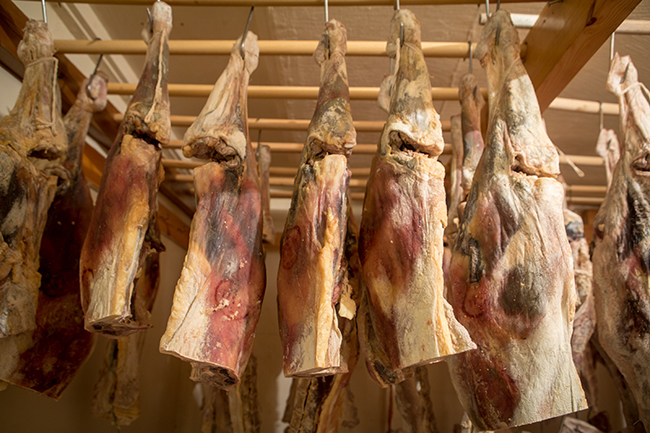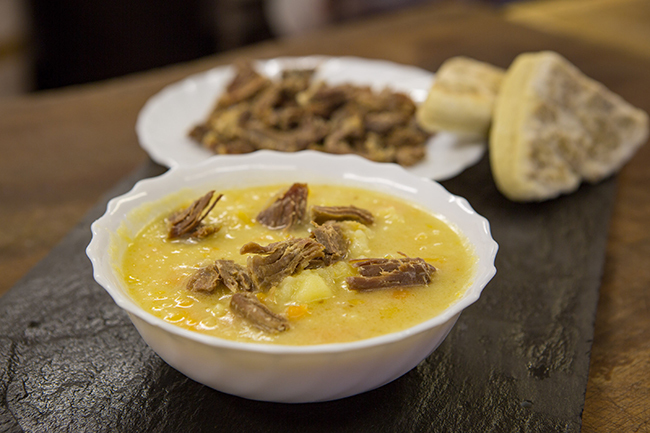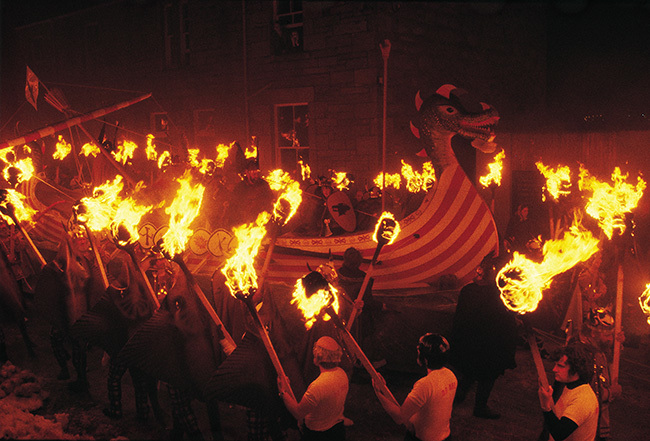
Getting set to enjoy Shetland’s national dish – reestit mutton
Preparations for Shetland’s traditional Up Helly Aa event are continuing, and attendees are getting ready for reestit mutton.
The essence of slow food is that it strives to preserve traditional and regional cuisine, and encourages farming of plants, seeds, and livestock characteristic of the local ecosystem.
That definition of slow food could not be more true than for Shetland’s own reestit mutton. This is a delicacy that is now only produced in Shetland, and is made from PDO Shetland sheep.
Protected Designation of Origin (PDO) status is the EU protected food name scheme which covers regional and traditional foods whose authenticity and origin can be guaranteed.

Reestit mutton is a delicacy that is only produced in Shetland
It is traditionally eaten at Up Helly Aa – the fire festival which is held at the end of January in the Shetland Islands – Tuesday 30 January.
Many outwith the Islands have probably never heard of reestit mutton, so here’s a guide to what is known as the nearest there is to Shetland’s national dish.
1. What is reestit mutton?
Reestit mutton is a traditional Shetland way of preserving mutton.
2. How was reestit mutton traditionally made?
In the traditional single-storey Shetland croft house there was no loft. The ‘reest’ is the area in the rafters where peat smoke gathered, and where ‘tees’ (legs) were hung to cure after soaking in brine. Today we do not have open peat fires, but the reestit mutton is still made by brining and then drying the meat.
3. Is reestit mutton produced only in The Shetland Islands?
Reestit mutton is now produced solely in Shetland, and reflects the influences from Scandinavia on the islands where similar techniques are used for preserving meat in this way.
4. How long will reestit mutton keep for?
Once dry, it can keep for up to four years.

Taatie Soup with Reestit Mutton
5. What is reestit mutton eaten with traditionally?
Traditionally it is eaten with Taatie Soup, in broths or in pies, or eaten cold in a Shetland bannock.
6. What is it reestit mutton not lamb?
The difference lies in the age of the sheep. The mutton to be reestit will be a hog – maybe 18 months or a bit older, certainly after their ‘hard teeth’ are through which replace the ‘lambing’ teeth.

The night time procession in Up Helly Aa
7. How long does it take to make?
Producers of reestit mutton, Anderson Butchers Ltd, say it takes at least eight weeks to make. The mutton is in the brine pickle for two to three weeks. Then the meat is hung up to dry which takes about five weeks and gets even better the longer it is left to hang. Once you have your piece of reestit mutton it needs to be covered in cold water and brought to the boil, and then allow it to simmer for a good 30 minutes.
8. What role does reestit mutton play in Shetland life now?
Reestit mutton is eaten at New Year to welcome ‘first footers’, and at Up Helly Aa – the fire festival which is held every January in the Shetland Islands. Meat was traditionally a cold-weather feast in Shetland as the older sheep would be slaughtered and prepared for the winter months. Reestit mutton is a key ingredient of many favourite dishes today cooked at home, and Anderson Butchers makes and sells reestit mutton pies from locally reared sheep.
9. Do any chefs cook with reestit mutton?
Award-winning chef Martin Wishart certainly does and says: ‘If one dish sums up the Shetland Islands, where my family are from, it has to be reestit mutton soup… and I even made it for my boss, Michel Roux, when I worked at Le Gavroche.’
10. Is reestit mutton Shetland’s national dish?
Many folk in Shetland think reestit mutton is the closest contender to being Shetland’s national dish.
Reestit mutton is available to order, and there is a recipe in Marian Armitage’s book Shetland Food and Cooking for Taatie Soup with Reestit Mutton. And a traditional recipe for Pickled Mutton in Cookery for Northern Wives by Margaret B Stout, first published in 1925. Both books are available to order from tasteofshetland.com.
TAGS

